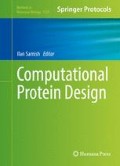Abstract
Monomeric proteins with a number of identical repeats creating symmetrical structures are potentially very valuable building blocks with a variety of bionanotechnological applications. As such proteins do not occur naturally, the emerging field of computational protein design serves as an excellent tool to create them from nonsymmetrical templates. Existing pseudo-symmetrical proteins are believed to have evolved from oligomeric precursors by duplication and fusion of identical repeats. Here we describe a computational workflow to reverse-engineer this evolutionary process in order to create stable proteins consisting of identical sequence repeats.
Access this chapter
Tax calculation will be finalised at checkout
Purchases are for personal use only
References
Goodsell DS, Olson AJ (2000) Structural symmetry and protein function. Annu Rev Biophys Biomol Struct 29:105–153. doi:10.1146/annurev.biophys.29.1.105
Caetano-Anolles G, Wang M, Caetano-Anolles D, Mittenthal JE (2009) The origin, evolution and structure of the protein world. Biochem J 417(3):621–637. doi:10.1042/BJ20082063
Jorda J, Xue B, Uversky VN, Kajava AV (2010) Protein tandem repeats—the more perfect, the less structured. FEBS J 277(12):2673–2682. doi:10.1111/j.1742-464X.2010.07684.x
Jorda J, Kajava AV (2010) Protein homorepeats sequences, structures, evolution, and functions. Adv Protein Chem Struct Biol 79:59–88. doi:10.1016/S1876-1623(10)79002-7
Kinch LN, Grishin NV (2002) Evolution of protein structures and functions. Curr Opin Struct Biol 12(3):400–408
Brych SR, Dubey VK, Bienkiewicz E, Lee J, Logan TM, Blaber M (2004) Symmetric primary and tertiary structure mutations within a symmetric superfold: a solution, not a constraint, to achieve a foldable polypeptide. J Mol Biol 344(3):769–780. doi:10.1016/j.jmb.2004.09.060
Zhang J, Zheng F, Grigoryan G (2014) Design and designability of protein-based assemblies. Curr Opin Struct Biol 27:79–86. doi:10.1016/j.sbi.2014.05.009
Sawyer N, Chen J, Regan L (2013) All repeats are not equal: a module-based approach to guide repeat protein design. J Mol Biol 425(10):1826–1838. doi:10.1016/j.jmb.2013.02.013
Pluckthun A (2015) Designed ankyrin repeat proteins (DARPins): binding proteins for research, diagnostics, and therapy. Annu Rev Pharmacol Toxicol 55:489–511. doi:10.1146/annurev-pharmtox-010611-134654
Park K, Shen BW, Parmeggiani F, Huang PS, Stoddard BL, Baker D (2015) Control of repeat-protein curvature by computational protein design. Nat Struct Mol Biol 22(2):167–174. doi:10.1038/nsmb.2938
Parmeggiani F, Huang PS, Vorobiev S, Xiao R, Park K, Caprari S, Su M, Seetharaman J, Mao L, Janjua H, Montelione GT, Hunt J, Baker D (2015) A general computational approach for repeat protein design. J Mol Biol 427(2):563–575. doi:10.1016/j.jmb.2014.11.005
Thomson AR, Wood CW, Burton AJ, Bartlett GJ, Sessions RB, Brady RL, Woolfson DN (2014) Computational design of water-soluble alpha-helical barrels. Science 346(6208):485–488. doi:10.1126/science.1257452
Lanci CJ, MacDermaid CM, Kang SG, Acharya R, North B, Yang X, Qiu XJ, DeGrado WF, Saven JG (2012) Computational design of a protein crystal. Proc Natl Acad Sci U S A 109(19):7304–7309. doi:10.1073/pnas.1112595109
Broom A, Doxey AC, Lobsanov YD, Berthin LG, Rose DR, Howell PL, McConkey BJ, Meiering EM (2012) Modular evolution and the origins of symmetry: reconstruction of a three-fold symmetric globular protein. Structure 20(1):161–171. doi:10.1016/j.str.2011.10.021
Lee J, Blaber SI, Dubey VK, Blaber M (2011) A polypeptide “building block” for the beta-trefoil fold identified by “top-down symmetric deconstruction”. J Mol Biol 407(5):744–763. doi:10.1016/j.jmb.2011.02.002
Paoli M (2001) Protein folds propelled by diversity. Prog Biophys Mol Biol 76(1–2):103–130
Voet AR, Noguchi H, Addy C, Simoncini D, Terada D, Unzai S, Park SY, Zhang KY, Tame JR (2014) Computational design of a self-assembling symmetrical beta-propeller protein. Proc Natl Acad Sci U S A 111(42):15102–15107. doi:10.1073/pnas.1412768111
Voet AR, Noguchi H, Addy C, Zhang KY, Tame JR (2015) Biomineralization of a cadmium chloride nano-crystal by a designed symmetrical protein. Angew Chem Int Ed Engl. doi:10.1002/anie.201503575R1
Delano WL (2010) The PyMOL molecular graphics system, version 1.3. Schrödinger, LLC
Pettersen EF, Goddard TD, Huang CC, Couch GS, Greenblatt DM, Meng EC, Ferrin TE (2004) UCSF Chimera—a visualization system for exploratory research and analysis. J Comput Chem 25(13):1605–1612. doi:10.1002/jcc.20084
Gille C (2005) STRAP. http://www.bioinformatics.com/STRAP
Retief JD (2000) Phylogenetic analysis using PHYLIP. Methods Mol Biol 132:243–258
Ashkenazy H, Penn O, Doron-Faigenboim A, Cohen O, Cannarozzi G, Zomer O, Pupko T (2012) FastML: a web server for probabilistic reconstruction of ancestral sequences. Nucleic Acids Res 40(web server issue):W580–W584. doi:10.1093/nar/gks498
Kaufmann KW, Lemmon GH, Deluca SL, Sheehan JH, Meiler J (2010) Practically useful: what the Rosetta protein modeling suite can do for you. Biochemistry 49(14):2987–2998. doi:10.1021/bi902153g
Chaudhury S, Lyskov S, Gray JJ (2010) PyRosetta: a script-based interface for implementing molecular modeling algorithms using Rosetta. Bioinformatics 26(5):689–691. doi:10.1093/bioinformatics/btq007
Andreeva A, Howorth D, Chothia C, Kulesha E, Murzin AG (2015) Investigating protein structure and evolution with SCOP2. Curr Protoc Bioinformatics 49:1.26.1–1.26.21. doi:10.1002/0471250953.bi0126s49
Acknowledgements
AV acknowledges RIKEN’s program for Junior Scientists for the FPR fellowship and funding.
Author information
Authors and Affiliations
Corresponding author
Editor information
Editors and Affiliations
Rights and permissions
Copyright information
© 2017 Springer Science+Business Media New York
About this protocol
Cite this protocol
Voet, A.R.D., Simoncini, D., Tame, J.R.H., Zhang, K.Y.J. (2017). Evolution-Inspired Computational Design of Symmetric Proteins. In: Samish, I. (eds) Computational Protein Design. Methods in Molecular Biology, vol 1529. Humana Press, New York, NY. https://doi.org/10.1007/978-1-4939-6637-0_16
Download citation
DOI: https://doi.org/10.1007/978-1-4939-6637-0_16
Published:
Publisher Name: Humana Press, New York, NY
Print ISBN: 978-1-4939-6635-6
Online ISBN: 978-1-4939-6637-0
eBook Packages: Springer Protocols

